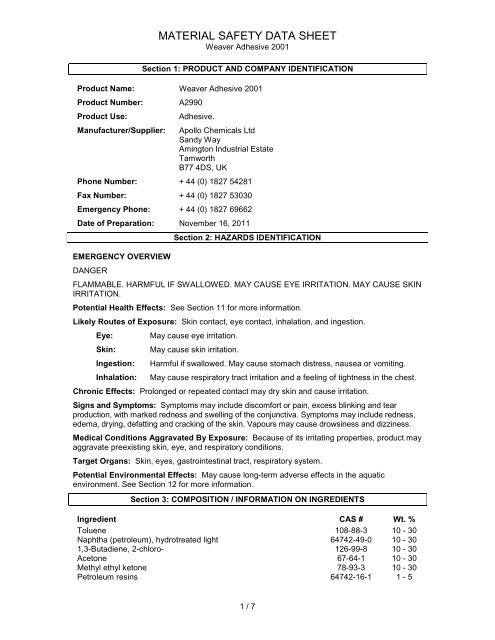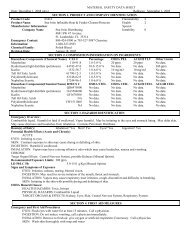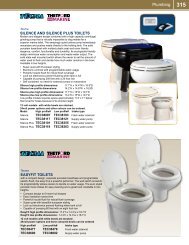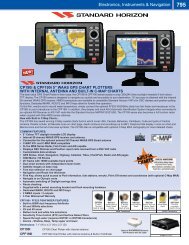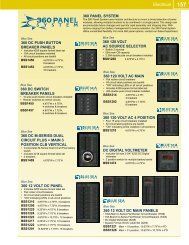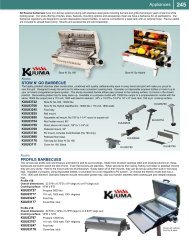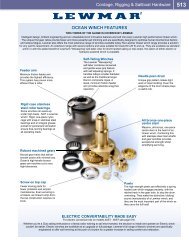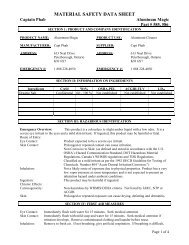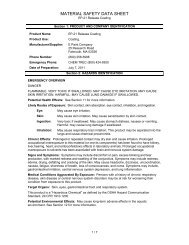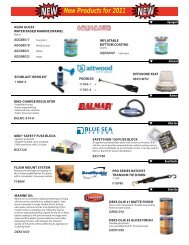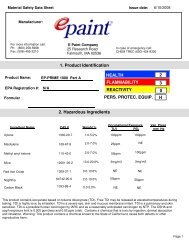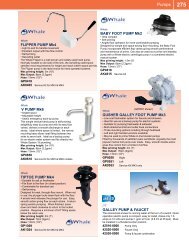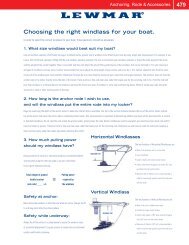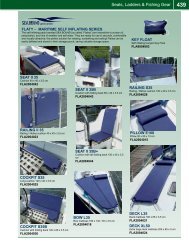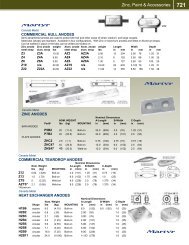Hypalon glue - Paynes Marine Group
Hypalon glue - Paynes Marine Group
Hypalon glue - Paynes Marine Group
You also want an ePaper? Increase the reach of your titles
YUMPU automatically turns print PDFs into web optimized ePapers that Google loves.
MATERIAL SAFETY DATA SHEET<br />
Weaver Adhesive 2001<br />
Section 1: PRODUCT AND COMPANY IDENTIFICATION<br />
Product Name: Weaver Adhesive 2001<br />
Product Number:<br />
Product Use:<br />
Manufacturer/Supplier:<br />
A2990<br />
Adhesive.<br />
Apollo Chemicals Ltd<br />
Sandy Way<br />
Amington Industrial Estate<br />
Tamworth<br />
B77 4DS, UK<br />
Phone Number: + 44 (0) 1827 54281<br />
Fax Number: + 44 (0) 1827 53030<br />
Emergency Phone: + 44 (0) 1827 69662<br />
Date of Preparation: November 16, 2011<br />
EMERGENCY OVERVIEW<br />
DANGER<br />
Section 2: HAZARDS IDENTIFICATION<br />
FLAMMABLE. HARMFUL IF SWALLOWED. MAY CAUSE EYE IRRITATION. MAY CAUSE SKIN<br />
IRRITATION.<br />
Potential Health Effects: See Section 11 for more information.<br />
Likely Routes of Exposure: Skin contact, eye contact, inhalation, and ingestion.<br />
Eye:<br />
Skin:<br />
Ingestion:<br />
Inhalation:<br />
May cause eye irritation.<br />
May cause skin irritation.<br />
Harmful if swallowed. May cause stomach distress, nausea or vomiting.<br />
May cause respiratory tract irritation and a feeling of tightness in the chest.<br />
Chronic Effects: Prolonged or repeated contact may dry skin and cause irritation.<br />
Signs and Symptoms: Symptoms may include discomfort or pain, excess blinking and tear<br />
production, with marked redness and swelling of the conjunctiva. Symptoms may include redness,<br />
edema, drying, defatting and cracking of the skin. Vapours may cause drowsiness and dizziness.<br />
Medical Conditions Aggravated By Exposure: Because of its irritating properties, product may<br />
aggravate preexisting skin, eye, and respiratory conditions.<br />
Target Organs: Skin, eyes, gastrointestinal tract, respiratory system.<br />
Potential Environmental Effects: May cause long-term adverse effects in the aquatic<br />
environment. See Section 12 for more information.<br />
Section 3: COMPOSITION / INFORMATION ON INGREDIENTS<br />
Ingredient CAS # Wt. %<br />
Toluene 108-88-3 10 - 30<br />
Naphtha (petroleum), hydrotreated light 64742-49-0 10 - 30<br />
1,3-Butadiene, 2-chloro- 126-99-8 10 - 30<br />
Acetone 67-64-1 10 - 30<br />
Methyl ethyl ketone 78-93-3 10 - 30<br />
Petroleum resins 64742-16-1 1 - 5<br />
1 / 7
Eye Contact:<br />
Skin Contact:<br />
Inhalation:<br />
Ingestion:<br />
MATERIAL SAFETY DATA SHEET<br />
Weaver Adhesive 2001<br />
Section 4: FIRST AID MEASURES<br />
In case of contact, immediately flush eyes with plenty of water for at least 15 minutes.<br />
If easy to do, remove contact lenses, if worn. Get medical attention immediately.<br />
In case of contact, immediately flush skin with plenty of water. Remove<br />
contaminated clothing and shoes. Wash clothing before reuse. Call a physician<br />
if irritation develops and persists.<br />
Remove to fresh air. If symptoms persist, obtain medical attention.<br />
Do NOT induce vomiting. Have victim rinse mouth thoroughly with water. If<br />
conscious and alert, have victim drink plenty of water. Never give anything by<br />
mouth to an unconscious person. Seek medical attention or call poison control.<br />
General Advice: In case of accident or if you feel unwell, seek medical advice immediately<br />
(show the label or MSDS where possible).<br />
Note to Physicians: Symptoms may not appear immediately.<br />
Flammability: Flammable by WHMIS criteria.<br />
Means of Extinction:<br />
Section 5: FIRE FIGHTING MEASURES<br />
Suitable Extinguishing Media: Powder, foam, carbon dioxide.<br />
Unsuitable Extinguishing Media: Water spray may be ineffective on fire but may protect<br />
firefighters and cool closed containers.<br />
Products of Combustion: May include, and are not limited to: oxides of carbon, noxious fumes.<br />
Explosion Data:<br />
Sensitivity to Mechanical Impact: Not available.<br />
Sensitivity to Static Discharge: Prevent the accumulation of electrostatic charge.<br />
Protection of Firefighters: Keep upwind of fire. Wear full fire fighting turn-out gear (full Bunker<br />
gear) and respiratory protection (SCBA).<br />
Section 6: ACCIDENTAL RELEASE MEASURES<br />
Personal Precautions: Use personal protection recommended in Section 8. Isolate the hazard<br />
area and deny entry to unnecessary and unprotected personnel. Eliminate sources of ignition.<br />
Environmental Precautions: Many gases are heavier than air and will spread along ground<br />
and collect in low or confined areas (sewers, basements, tanks). Keep out of drains, sewers,<br />
ditches, and waterways. Minimize use of water to prevent environmental contamination.<br />
Methods for Containment: Contain and/or absorb spill with inert material (e.g. sand,<br />
vermiculite), then place in a suitable container. Do not flush to sewer or allow to enter<br />
waterways. Use appropriate Personal Protective Equipment (PPE).<br />
Methods for Clean-Up: Scoop up material and place in a disposal container. Provide ventilation.<br />
Other Information: Not available.<br />
2 / 7
MATERIAL SAFETY DATA SHEET<br />
Weaver Adhesive 2001<br />
Section 7: HANDLING AND STORAGE<br />
Handling:<br />
Keep away from sources of ignition. No smoking. Avoid contact with skin and eyes. Do not<br />
swallow. Do not breathe gas/fumes/vapor/spray. Use only in well-ventilated areas. Handle and<br />
open container with care. When using do not eat or drink. Wash hands before eating, drinking, or<br />
smoking.<br />
Storage:<br />
Keep out of the reach of children. Keep container tightly closed and in a well-ventilated place.<br />
Store in a cool place, away from incompatibles.<br />
Exposure Guidelines<br />
Section 8: EXPOSURE CONTROLS / PERSONAL PROTECTION<br />
Ingredient<br />
Toluene<br />
Naphtha (petroleum), hydrotreated light<br />
1,3-Butadiene, 2-chloro-<br />
Acetone<br />
Methyl ethyl ketone<br />
Petroleum resins<br />
Exposure Limits<br />
ACGIH-TLV<br />
20 ppm<br />
Not available.<br />
10 ppm<br />
500 ppm<br />
200 ppm<br />
Not available.<br />
Engineering Controls: Use ventilation adequate to keep exposures (airborne levels of dust,<br />
fume, vapor, etc.) below recommended exposure limits.<br />
Personal Protective Equipment:<br />
Eye/Face Protection: Wear eye/face protection.<br />
Hand Protection: Impervious protective gloves are recommended.<br />
Skin and Body Protection: Impervious protective clothing recommended.<br />
Respiratory Protection: A NIOSH approved organic vapor respirator is recommended in<br />
poorly ventilated areas or when permissible exposure limits may be exceeded. A selfcontained<br />
breathing apparatus (SCBA) may be required for unknown vapour concentrations.<br />
General Hygiene Considerations: Handle according to established industrial hygiene and<br />
safety practices.<br />
Section 9: PHYSICAL AND CHEMICAL PROPERTIES<br />
Appearance:<br />
Colour:<br />
Odour:<br />
Odour Threshold:<br />
Physical State:<br />
pH:<br />
Viscosity:<br />
Freezing Point:<br />
Boiling Point:<br />
Flash Point:<br />
Viscous.<br />
Cream.<br />
Characteristic.<br />
Not available.<br />
Liquid.<br />
Not available.<br />
1848 cSt @ 40 °C (104 °F)<br />
Not available.<br />
~ 56 °C (133 °F)<br />
~ -35 °C (-31 °F)<br />
3 / 7
Evaporation Rate:<br />
MATERIAL SAFETY DATA SHEET<br />
Weaver Adhesive 2001<br />
Fast.<br />
Lower Flammability Limit: 0.9<br />
Upper Flammability Limit: 8<br />
Vapor Pressure:<br />
Vapor Density:<br />
Specific Gravity: 0.85<br />
Solubility in Water:<br />
Coefficient of Water/Oil Distribution:<br />
Auto-ignition Temperature:<br />
Percent Volatile, wt. %:<br />
VOC content, wt. %:<br />
Not available.<br />
Not available.<br />
Insoluble.<br />
Not available.<br />
~ 200 °C (392 °F)<br />
Not available.<br />
Not available.<br />
Section 10: STABILITY AND REACTIVITY<br />
Stability: Stable under normal storage conditions. Keep in a cool place.<br />
Conditions of Reactivity: Heat. Incompatible materials.<br />
Incompatible Materials: Strong oxidizers. Strong acids.<br />
Hazardous Decomposition Products: May include, and are not limited to: oxides of carbon,<br />
noxious fumes.<br />
Possibility of Hazardous Reactions: In use, may form flammable/explosive vapour-air mixture.<br />
EFFECTS OF ACUTE EXPOSURE<br />
Component Analysis<br />
Section 11: TOXICOLOGY INFORMATION<br />
Ingredient LD 50 (oral) LC 50<br />
Toluene<br />
636 mg/kg, rat<br />
12.5 mg/L 4hr, rat;<br />
26700 ppm 1hr, rat<br />
Naphtha (petroleum), hydrotreated light > 5000 mg/kg, rat 73680 ppm 4hr, rat<br />
1,3-Butadiene, 2-chloro- 450 mg/kg, rat 11.8 mg/L 4 hr, rat<br />
Acetone 5800 mg/kg, rat Not available.<br />
Methyl ethyl ketone 2737 mg/kg, rat 23500 mg/m³ 8hr, rat<br />
Petroleum resins Not available. Not available.<br />
Eye:<br />
Skin:<br />
Ingestion:<br />
Inhalation:<br />
May cause eye irritation. Symptoms may include discomfort or pain, excess blinking<br />
and tear production, with marked redness and swelling of the conjunctiva.<br />
May cause skin irritation. Symptoms may include redness, edema, drying,<br />
defatting and cracking of the skin.<br />
Harmful if swallowed. May cause stomach distress, nausea or vomiting.<br />
May cause respiratory tract irritation and a feeling of tightness in the chest. Vapours<br />
may cause drowsiness and dizziness.<br />
EFFECTS OF CHRONIC EXPOSURE<br />
Target Organs: Not available.<br />
Chronic Effects: Not hazardous by WHMIS criteria.<br />
Carcinogenicity: Hazardous by WHMIS criteria.<br />
4 / 7
Ingredient<br />
Toluene<br />
Naphtha (petroleum), hydrotreated light<br />
1,3-Butadiene, 2-chloro-<br />
Acetone<br />
Methyl ethyl ketone<br />
Petroleum resins<br />
* See Section 15 for more information.<br />
MATERIAL SAFETY DATA SHEET<br />
Weaver Adhesive 2001<br />
Mutagenicity: Not hazardous by WHMIS criteria.<br />
Reproductive Effects: Not hazardous by WHMIS criteria.<br />
Developmental Effects:<br />
Teratogenicity: Hazardous by WHMIS criteria.<br />
Embryotoxicity: Hazardous by WHMIS criteria.<br />
Respiratory Sensitization: Not hazardous by WHMIS criteria.<br />
Skin Sensitization: Not hazardous by WHMIS criteria.<br />
Toxicologically Synergistic Materials: Not available.<br />
Section 12: ECOLOGICAL INFORMATION<br />
Chemical Listed as Carcinogen or<br />
Potential Carcinogen *<br />
G-A4, I-3, CP65<br />
Not listed.<br />
I-2B, N-2, CP65<br />
G-A4<br />
Not listed.<br />
Not listed.<br />
Ecotoxicity: May cause long-term adverse effects in the aquatic environment.<br />
Persistence / Degradability: Not available.<br />
Bioaccumulation / Accumulation: Not available.<br />
Mobility in Environment: Volatile.<br />
Section 13: DISPOSAL CONSIDERATIONS<br />
Disposal Instructions:<br />
This material must be disposed of in accordance with all local, state, provincial, and federal regulations.<br />
Section 14: TRANSPORTATION INFORMATION<br />
TDG Classification<br />
UN1133; ADHESIVES containing flammable liquid; Class 3; PG II<br />
Limited Quantity (≤ 5L)<br />
Federal Regulations<br />
Section 15: REGULATORY INFORMATION<br />
Canadian: This product has been classified in accordance with the hazard criteria of the<br />
Controlled Products Regulations and the MSDS contains all the information required by the<br />
Controlled Products Regulations.<br />
5 / 7
Global Inventories<br />
Ingredient<br />
Toluene<br />
Naphtha (petroleum), hydrotreated light<br />
1,3-Butadiene, 2-chloro-<br />
Acetone<br />
Methyl ethyl ketone<br />
Petroleum resins<br />
MATERIAL SAFETY DATA SHEET<br />
Weaver Adhesive 2001<br />
HMIS - Hazardous Materials Identification System<br />
Health - 2* Flammability - 3 Physical Hazard - 1 PPE – B<br />
NFPA - National Fire Protection Association:<br />
Health - 2 Fire - 3 Reactivity - 1<br />
Hazard Rating: 0 = minimal, 1 = slight, 2 = moderate, 3 = severe, 4 = extreme<br />
WHMIS Classification(s):<br />
Class B2 - Flammable Liquid<br />
Class D2A - Carcinogenicity<br />
Class D2A - Teratogenicity and Embryotoxicity<br />
Class D2B - Skin/Eye Irritant<br />
Class F - Dangerously Reactive Material<br />
WHMIS Hazard Symbols:<br />
Canada<br />
DSL/NDSL<br />
DSL<br />
DSL<br />
DSL<br />
DSL<br />
DSL<br />
DSL<br />
SOURCE AGENCY CARCINOGEN CLASSIFICATIONS:<br />
OSHA (O)<br />
ACGIH (G)<br />
IARC (I)<br />
NTP (N)<br />
Occupational Safety and Health Administration.<br />
American Conference of Governmental Industrial Hygienists.<br />
A1 - Confirmed human carcinogen.<br />
A2 - Suspected human carcinogen.<br />
A3 - Animal carcinogen.<br />
A4 - Not classifiable as a human carcinogen.<br />
A5 - Not suspected as a human carcinogen.<br />
International Agency for Research on Cancer.<br />
1 - The agent (mixture) is carcinogenic to humans.<br />
2A - The agent (mixture) is probably carcinogenic to humans; there is limited evidence of carcinogenicity in<br />
humans and sufficient evidence of carcinogenicity in experimental animals.<br />
2B - The agent (mixture) is possibly carcinogenic to humans; there is limited evidence of carcinogenicity in<br />
humans in the absence of sufficient evidence of carcinogenicity in experimental animals.<br />
3 - The agent (mixture, exposure circumstance) is not classifiable as to its carcinogenicity to humans.<br />
4 - The agent (mixture, exposure circumstance) is probably not carcinogenic to humans.<br />
National Toxicology Program.<br />
1 - Known to be carcinogens.<br />
2 - Reasonably anticipated to be carcinogens.<br />
6 / 7
MATERIAL SAFETY DATA SHEET<br />
Weaver Adhesive 2001<br />
Section 16: OTHER INFORMATION<br />
Disclaimer:<br />
The information contained in this document applies to this specific material as supplied. It may<br />
not be valid for this material if it is used in combination with any other materials. It is the user’s<br />
responsibility to satisfy oneself as to the suitability and completeness of this information for the<br />
user’s own particular use.<br />
Expiry Date: November 16, 2014<br />
Version #: 1.0<br />
Prepared by:<br />
Nexreg Compliance Inc.<br />
Phone: (519) 488-5126<br />
www.nexreg.com<br />
7 / 7


